Evaluation of the Energy Consumption and Fractal Characteristics of Different Length-Diameter Ratios of Coal under Dynamic Impact
Abstract
:1. Introduction
2. Materials and Methods
2.1. Sample Preparation
2.2. Loading Plan
2.3. Processing Experimental Data
3. Results
3.1. Stress–Strain Curve
3.2. Energy Dissipation
3.3. Crushing Morphology
3.4. Characteristics of Fragmentation Size Distribution
4. Discussion
4.1. Proportion of Crushing Energy Consumption and Energy Consumption
4.2. Energy Dissipation Density
4.3. Crushing Density Energy Efficiency
4.4. Principles for Determining Pre-Splitting Blasting Parameters of Top Coal
5. Conclusions
- (1)
- The stress–strain curve of coal in different stages i.e., elastic, plastic, and failure, show similar shape (open) with various l/d. The plastic stage of the curve increases as the l/d ratio increases, and the phenomenon of strain-softening appears.
- (2)
- Dynamic compression of coal with different l/d shows similar changes in the dynamic compression energy dissipation and energy consumption ratio. There are two stages as the l/d increases, with a linear increase within the stages, and a step-by-step decline as a whole. It is the dispersion effect of the lateral inertia and the internal and external friction effects that cause the change in the energy absorption distribution of the specimen. The energy consumption density of the specimen is inversely proportional to the l/d.
- (3)
- The impact crushing characteristics of coals with different l/d were described using the average particle size of the fragments and the fractal dimension of broken fragmentation, which mutually confirmed that the degree of crushing gradually decreases as the l/d increases. The fractal dimension and the energy consumption density of coal specimens with varying l/d are proven to have a power relationship.
- (4)
- A new index, CDEE, is proposed to measure the efficiency of crushing energy utilized in rock breaking. The l/d is found to be inversely proportional to CDEE, revealing the weakening effect of longer coal samples on the efficiency of absorbing energy for crushing, but the effect decreases as the l/d increases.
- (5)
- To enhance the crushing efficiency of deep hole pre-splitting blasting, a technique for estimating the parameters of top coal pre-splitting blasting based on CDEE is proposed to tackle the issues of undeveloped top coal cracks, completeness, high hardness, and poor caving in top coal mining.
Author Contributions
Funding
Data Availability Statement
Conflicts of Interest
References
- Wang, W.; Zhao, Y.; Teng, T.; Zhang, C.; Jiao, Z. Influence of Bedding Planes on Mode I and Mixed-Mode (I–II) Dynamic Fracture Toughness of Coal: Analysis of Experiments. Rock Mech. Rock Eng. 2020, 54, 173–189. [Google Scholar] [CrossRef]
- Sheorey, P.; Barat, D.; Das, M.; Mukherjee, K.; Singh, B. Schmidt hammer rebound data for estimation of large scale in situ coal strength. Int. J. Rock Mech. Min. Sci. Geomech. Abstr. 1984, 21, 39–42. [Google Scholar] [CrossRef]
- Yin, Z.; Chen, W.; Hao, H.; Chang, J.; Zhao, G.; Chen, Z.; Peng, K. Dynamic Compressive Test of Gas-Containing Coal Using a Modified Split Hopkinson Pressure Bar System. Rock Mech. Rock Eng. 2019, 53, 815–829. [Google Scholar] [CrossRef]
- Nikolenko, P.V.; Epshtein, S.A.; Shkuratnik, V.L.; Anufrenkova, P.S. Experimental study of coal fracture dynamics under the influence of cyclic freezing–thawing using shear elastic waves. Int. J. Coal Sci. Technol. 2020, 8, 562–574. [Google Scholar] [CrossRef]
- Ita, S.; Cook, N.; Myer, L.; Nihei, K. Effects of stress anisotropy on the static and dynamic properties of Berea sandstone. Int. J. Rock Mech. Min. Sci. Geomech. Abstr. 1993, 30, 785–788. [Google Scholar] [CrossRef]
- Kou, S.-Q.; Rustan, A. Burden related to blasthole diameter in rock blasting. Int. J. Rock Mech. Min. Sci. Geomech. Abstr. 1992, 29, 543–553. [Google Scholar] [CrossRef]
- He, H.; Ahrens, T. Mechanical properties of shock-damaged rocks. Int. J. Rock Mech. Min. Sci. Geomech. Abstr. 1994, 31, 525–533. [Google Scholar] [CrossRef]
- Zhang, Z.; Kou, S.; Jiang, L.; Lindqvist, P.-A. Effects of loading rate on rock fracture: Fracture characteristics and energy partitioning. Int. J. Rock Mech. Min. Sci. 2000, 37, 745–762. [Google Scholar] [CrossRef]
- Weng, L.; Wu, Z.J.; Liu, Q.S.; Wang, Z.Y. Energy dissipation and dynamic fragmentation of dry and water-saturated silt-stones under sub-zero temperatures. Eng. Fract. Mech. 2019, 220, 106659. [Google Scholar] [CrossRef]
- Khan, N.M.; Ma, L.; Cao, K.; Hussain, S.; Liu, W.; Xu, Y. Infrared radiation characteristics based rock failure indicator index for acidic mudstone under uniaxial loading. Arab. J. Geosci. 2022, 15, 343. [Google Scholar] [CrossRef]
- Khan, N.M.; Ahmad, M.; Cao, K.; Ali, I.; Liu, W.; Rehman, H.; Hussain, S.; Rehman, F.U.; Ahmed, T. Developing a New Bursting Liability Index Based on Energy Evolution for Coal under Different Loading Rates. Sustainability 2022, 14, 1572. [Google Scholar] [CrossRef]
- Ma, L.; Khan, N.M.; Cao, K.; Rehman, H.; Salman, S.; Rehman, F.U. Prediction of Sandstone Dilatancy Point in Different Water Contents Using Infrared Radiation Characteristic: Experimental and Machine Learning Approaches. Lithosphere 2022, 2021, 3243070. [Google Scholar] [CrossRef]
- Wang, J.; Wei, W.; Zhang, J. Theoretical description of drawing body shape in an inclined seam with longwall top coal caving mining. Int. J. Coal Sci. Technol. 2019, 7, 182–195. [Google Scholar] [CrossRef] [Green Version]
- Jangara, H.; Ozturk, C.A. Longwall top coal caving design for thick coal seam in very poor strength surrounding strata. Int. J. Coal Sci. Technol. 2021, 8, 641–658. [Google Scholar] [CrossRef]
- Kolsky, H. An Investigation of the Mechanical Properties of Materials at very High Rates of Loading. Proc. Phys. Soc. Sect. B 1949, 62, 676–700. [Google Scholar] [CrossRef]
- Li, G.; Chen, Z.H.; Xie, Y.; Zu, W.H. Test research on dynamic characteristics of Three Gorges granite under high strain rate. Rock Soil Mech. 2007, 28, 1833–1840. [Google Scholar]
- Su, B.J.; Wang, Q.Z. Experimental study of dynamic mechanical properties for Quasi- brittle materials using the split Hopkinson pressure bar. Rock Soil Mech. 2003, S2, 580–584. [Google Scholar]
- Li, L.Y.; Xu, Z.J.; Xie, H.P.; JU, Y.; Ma, X.; Han, Z.C. Failure experimental study on energy laws of rock under differential dynamic impact velocities. J. Earthq. Eng. 2012, 36, 2007–2011. [Google Scholar]
- Yu, Y.Q.; Zhang, W.L.; Fan, L.D.; Gong, J.; Yang, M.; Sun, M. Study on strain rate effect and energy dissipation charac-teristics of coal measures sandstone under impact loading. J. China Coal Soc. 2021, 46, 2281–2293. [Google Scholar]
- Liu, S.H.; Mao, D.B.; Qi, Q.X.; Li, F.M. Under static loading stress wave propagation mechanism and energy dissipation in compound coal-rock. J. China Coal Soc. 2014, 39, 15–22. [Google Scholar]
- Weng, L.; Wu, Z.; Liu, Q. Dynamic Mechanical Properties of Dry and Water-Saturated Siltstones Under Sub-Zero Tem-peratures. Rock Mech. Rock Eng. 2020, 53, 4381–4401. [Google Scholar] [CrossRef]
- Zhou, Y.; Voyiadjis, G.Z. Rate Effect in Frictional Contact on Porous Rocks. Rock Mech. Rock Eng. 2021, 54, 1411–1430. [Google Scholar] [CrossRef]
- Li, X.B.; Lok, T.S.; Zhao, J. Dynamic Characteristics of Granite Subjected to Intermediate Loading Rate. Rock Mech. Rock Eng. 2004, 38, 21–39. [Google Scholar] [CrossRef]
- Krauthammer, T.; Elfahal, M.; Lim, J.; Ohno, T.; Beppu, M.; Markeset, G. Size effect for high-strength concrete cylinders subjected to axial impact. Int. J. Impact Eng. 2003, 28, 1001–1016. [Google Scholar] [CrossRef]
- Elfahal, M.M.; Krauthammer, T.; Ohno, T.; Beppu, M.; Mindess, S. Size effect for normal strength concrete cylinders sub-jected to axial impact. Int. J. Impact Eng. 2005, 31, 461–481. [Google Scholar] [CrossRef]
- Hong, L.; Li, X.B.; Ma, C.D.; Yin, T.B.; Ye, Z.Y.; Liao, G.Y. Study on size effect of rock dynamic strength and strain rate sensitivity. Chin. J. Rock Mech. Eng. 2008, 27, 526–533. [Google Scholar]
- Yan, Z.; Dai, F.; Zhu, J.; Xu, Y. Dynamic Cracking Behaviors and Energy Evolution of Multi-flawed Rocks Under Static Pre-compression. Rock Mech. Rock Eng. 2021, 54, 5117–5139. [Google Scholar] [CrossRef]
- Liu, X.H.; Zhang, R.; Liu, J.F. Dynamic test study of coal rock under different strain rates. J. China Coal Soc. 2012, 37, 1528–1534. [Google Scholar]
- Ma, Q.; Cao, Z. Experimental Study on Fractal Characteristics and Energy Dissipation of Stabilized Soil Based on SHPB Test. J. Mater. Civ. Eng. 2019, 31, 04019264. [Google Scholar] [CrossRef]
- Mandelbrot, B.B. Self-Affine Fractals and Fractal Dimension. Phys. Scr. 1985, 32, 257–260. [Google Scholar] [CrossRef]
- Tyler, S.W.; Wheatcraft, S.W. Fractal Scaling of Soil Particle-Size Distributions: Analysis and Limitations. Soil Sci. Soc. Am. J. 1992, 56, 362–369. [Google Scholar] [CrossRef]
- Tyler, S.W.; Wheatcraft, S.W. Application of Fractal Mathematics to Soil Water Retention Estimation. Soil Sci. Soc. Am. J. 1989, 53, 987–996. [Google Scholar] [CrossRef]
- Xie, H.P.; Gao, F.; Zhou, H.; Zuo, J.P. Fractal fracture and fragmentation in rocks. J. Huazhong Univ. Sci. Tech.-Med. 2003, 23, 1–9. [Google Scholar]
- Gao, F.; Xie, H.P. Fractal properties of size-frequency distribution of rock fragments and the influence of meso-structure. Chin. J. Rock Mech. Eng. 1994, 13, 240–246. [Google Scholar]
- Zhang, R.R.; Jing, L.W. Analysis on the fragment and energy dissipation of deep sandstone after high / low temperature treatment in shpb tests. J. China Coal Soc. 2018, 43, 1884–1892. [Google Scholar]
- Zhang, W.Q.; Shi, B.M.; Mu, C.M. Experimental research on failure and energy dissipation law of coal under impact load. J. Min. Safe. Eng. 2016, 33, 375–380. [Google Scholar]
- Liu, S.; Xu, J.Y.; Bai, E.L.; Gao, Z.G. Research on impact fracture of rock based on fractal theory. J. Vibra. Shoc. 2013, 32, 163–166. [Google Scholar]
- Cao, K.; Ma, L.; Wu, Y.; Khan, N.; Yang, J. Using the characteristics of infrared radiation during the process of strain energy evolution in saturated rock as a precursor for violent failure. Infrared Phys. Technol. 2020, 109, 103406. [Google Scholar] [CrossRef]
- Xie, H.P.; Ju, Y.; Li, L.Y.; Peng, R.D. Energy mechanism of deformation and failure of rock masses. Chin. J. Rock Mech. Eng. 2008, 27, 1729–1740. [Google Scholar]
- Zuo, J.P.; Wang, J.C.; Jiang, Y. Macro/meso failure behavior of surrounding rock in deep roadway and its control tech-nology. Int. J. Coal Sci. Technol. 2019, 6, 301–319. [Google Scholar] [CrossRef] [Green Version]
- Zhao, Y.; Zhou, H.; Zhong, J.; Liu, D. Study on the relation between damage and permeability of sandstone at depth under cyclic loading. Int. J. Coal Sci. Technol. 2019, 6, 479–492. [Google Scholar] [CrossRef] [Green Version]
- Zhou, Y.X.; Xia, K.; Li, X.B.; Li, H.B.; Ma, G.W.; Zhao, J.; Dai, F. Suggested methods for determining the dynamic strength parameters and mode-I fracture toughness of rock materials. Int. J. Rock Mech. Min. Sci. 2012, 49, 105–112. [Google Scholar] [CrossRef]
- Yin, L.; Li, M.; Sun, W.; Chen, J.; Liu, B.; Wang, Z. Mechanical Mechanism and Propagation Law of Fissure-Tip Cracks of Large-Size Rock Specimens with Two Precut Fissures. Shock Vib. 2021, 2021, 8812902. [Google Scholar] [CrossRef]
- Li, X.; Zou, Y.; Zhou, Z. Numerical Simulation of the Rock SHPB Test with a Special Shape Striker Based on the Discrete Element Method. Rock Mech. Rock Eng. 2013, 47, 1693–1709. [Google Scholar] [CrossRef]
- Cao, K.W.; Ma, L.Q.; Zhang, D.S.; Lai, X.P.; Zhang, Z.; Khan, N.M. An experimental study of infrared radiation charac-teristics of sandstone in dilatancy process. Int. J. Rock Mech. Min. Sci. 2020, 136, 104503–104513. [Google Scholar] [CrossRef]
- Faxu, D.; Zhang, P.; Sun, W.; Zhou, S.; Kong, L. Experimental research on the effect of water-rock interaction in filling media of fault structure. Geomech. Eng. 2021, 24, 471–478. [Google Scholar]
- Yuan, Q.; Xie, G.; Wang, L.; Jiao, Z.; Zou, P.; Liu, H.; Khan, N.M. Experimental Study on Stress Uniformity and Deformation Behavior of Coals with Different Length-to-Diameter Ratios under Dynamic Compression. Shock Vib. 2021, 2021, 6675200. [Google Scholar] [CrossRef]
- Wang, J.C. Engineering practice and theoretical progress of top-coal caving mining technology in China. China Coal Soc. 2018, 43, 43–51. [Google Scholar]
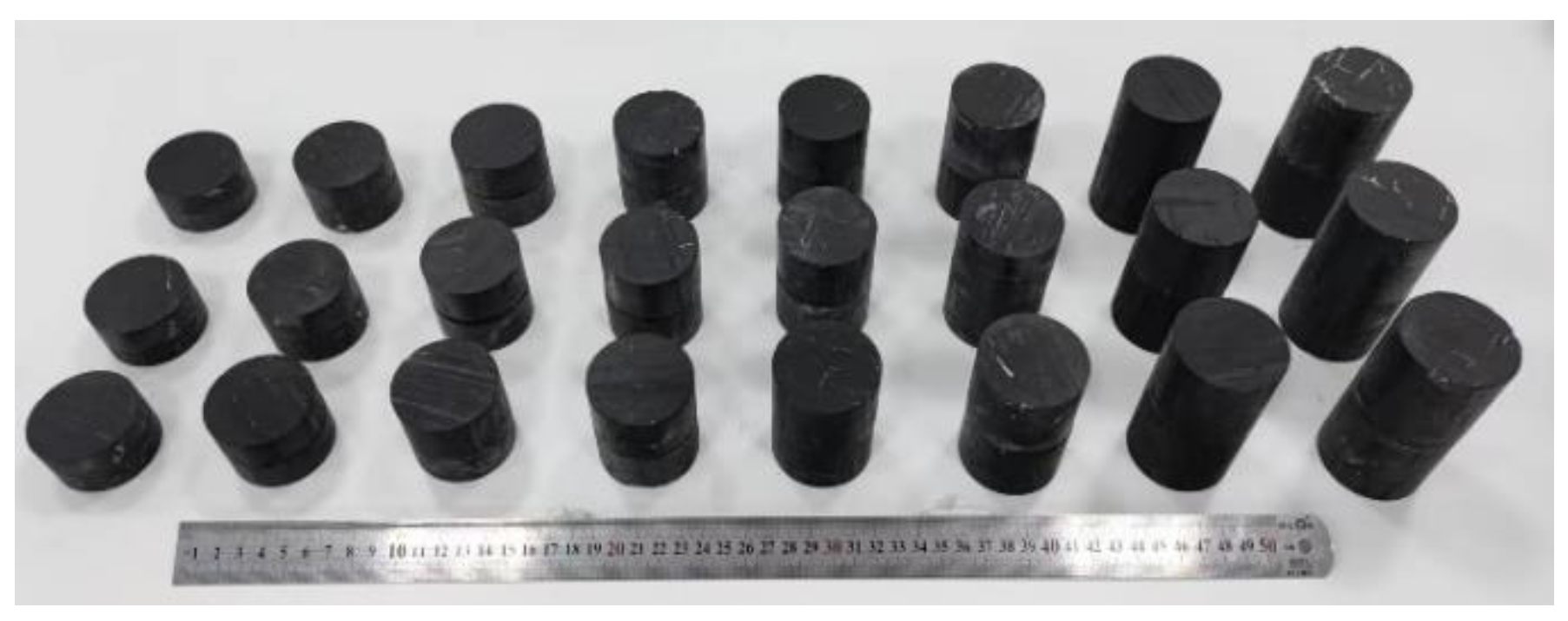


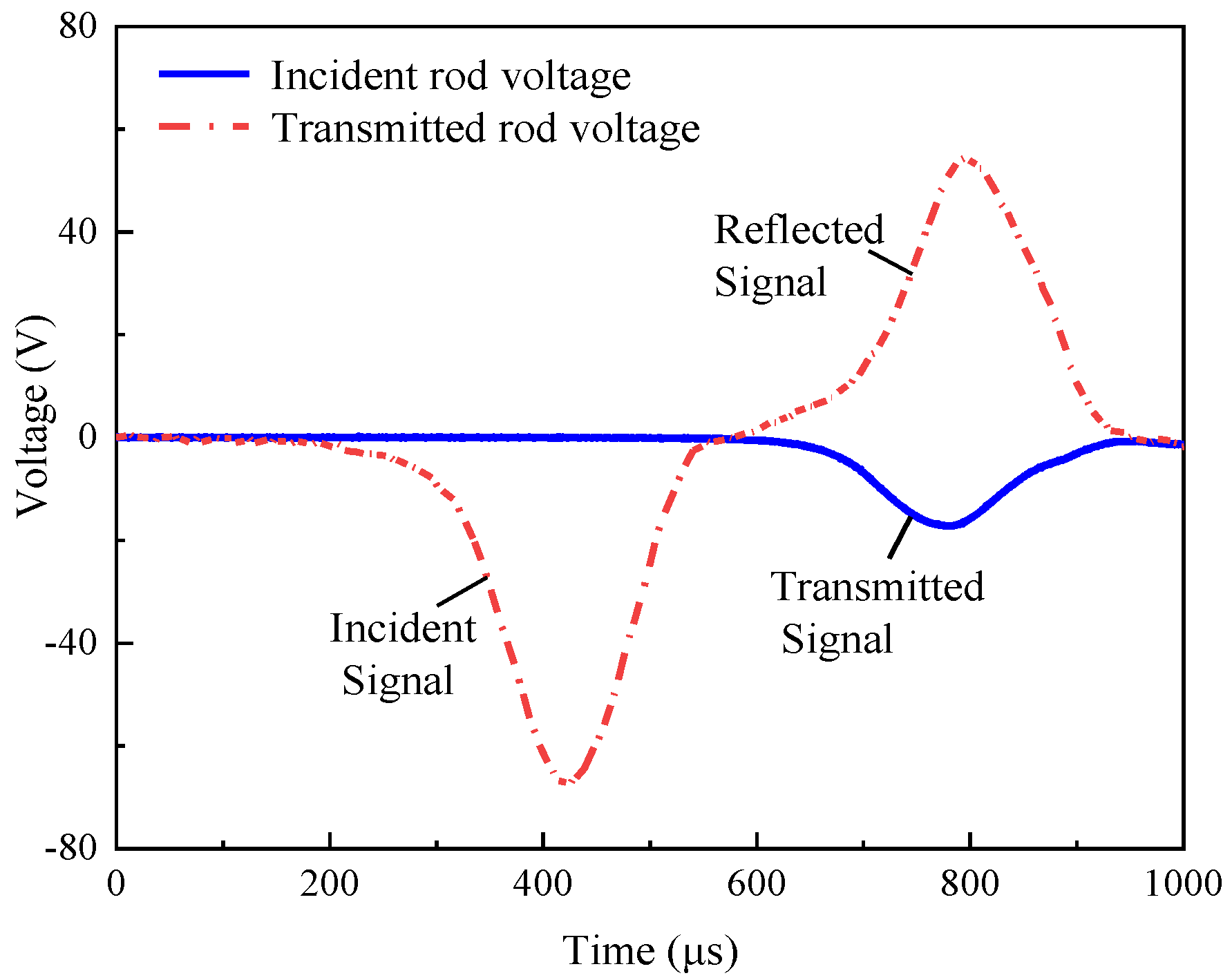


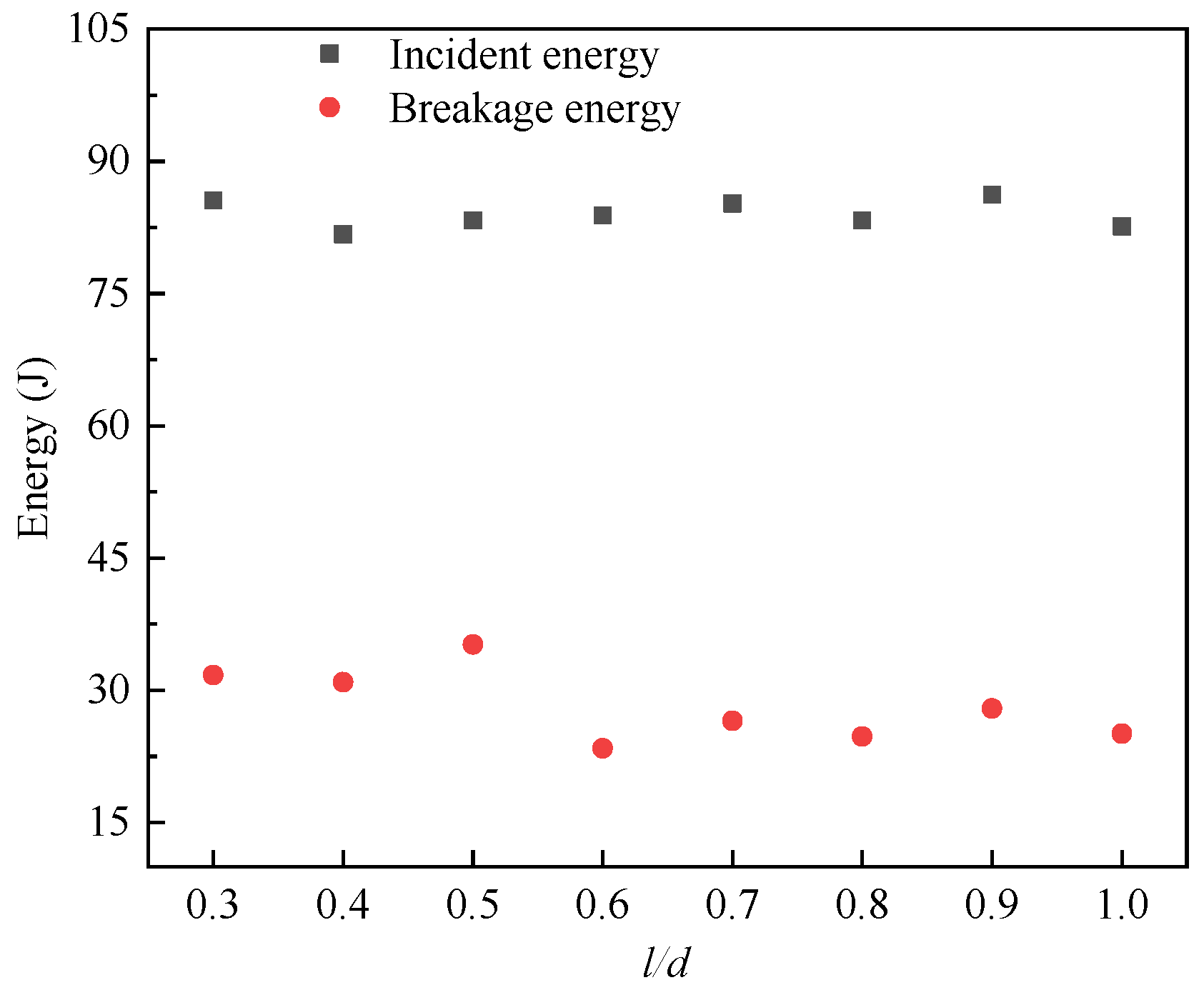

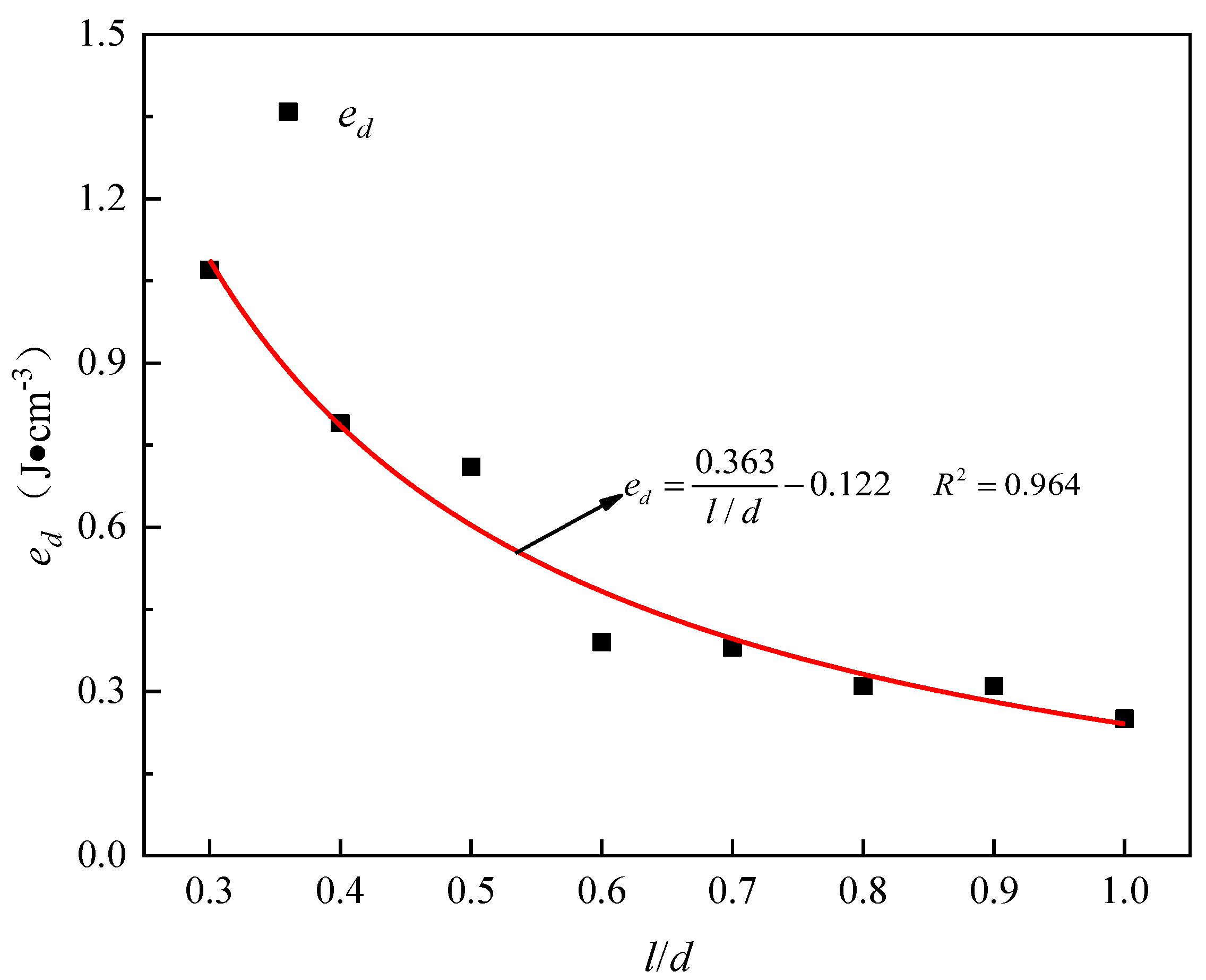
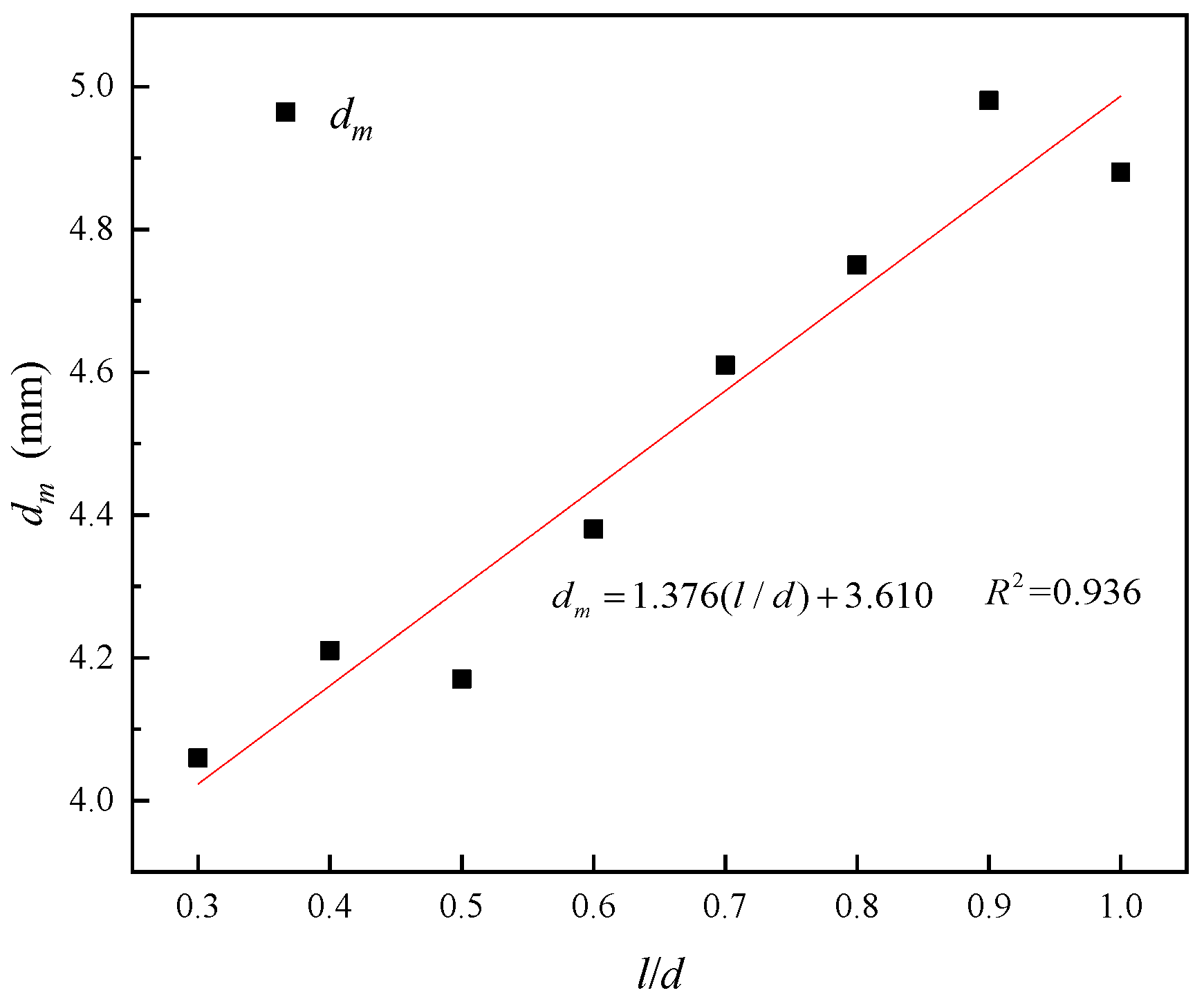


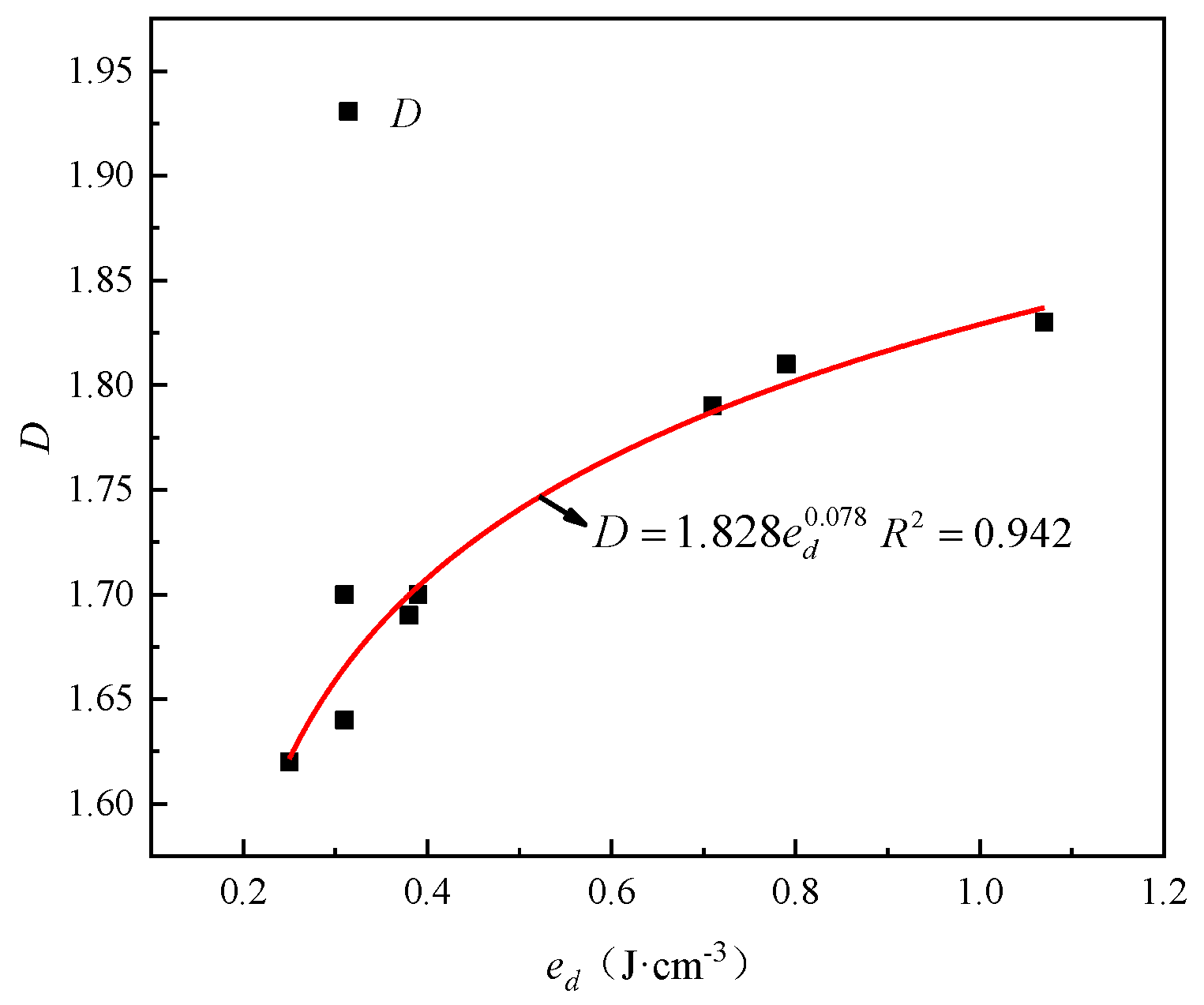
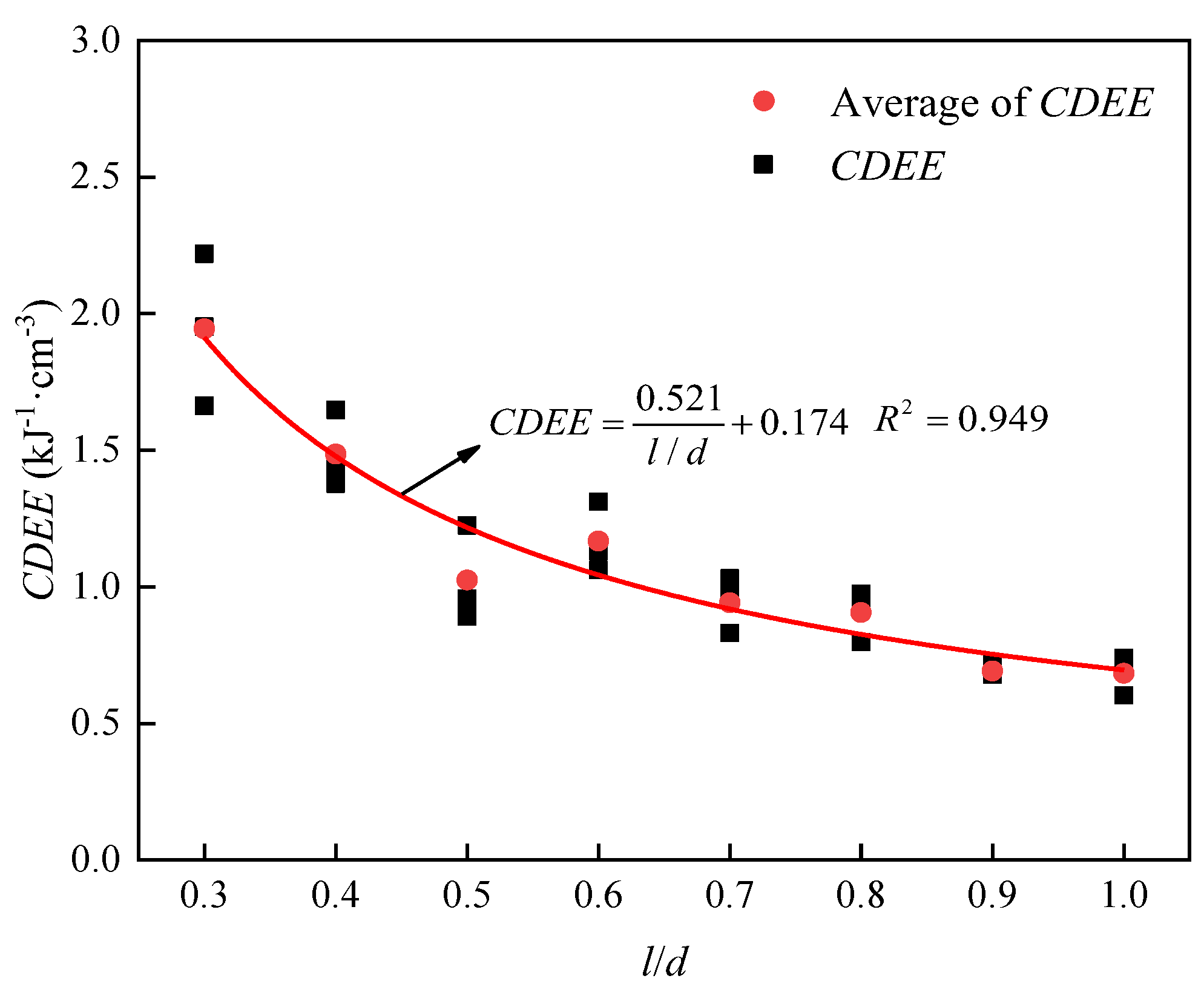
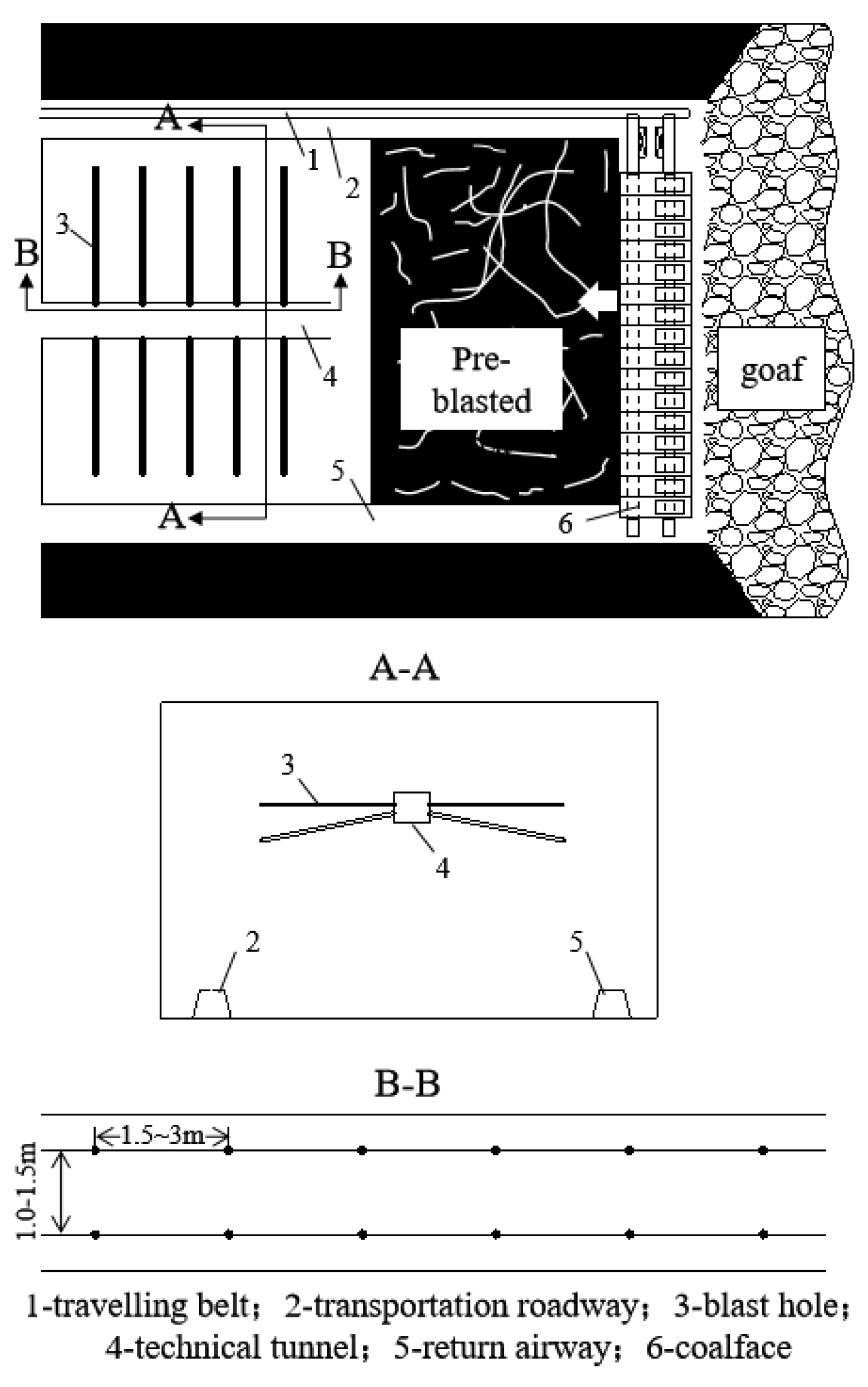
| Serial Number | L (mm) | σ (MPa) | (MPa)\ Std. Dev. | WI (J) | \ Std. Dev. | WFD (J) | (J)\ Std. Dev. | ed (J·cm−3) | (J·cm−3)\ Std. Dev. | P | \Std. Dev. |
|---|---|---|---|---|---|---|---|---|---|---|---|
| 0.3–1 | 14.53 | 41.70 | 38.54\2.57 | 82.26 | 88.55\2.89 | 28.68 | 31.74\3.23 | 1.01 | 1.07\0.078 | 0.35 | 0.37\0.026 |
| 0.3–2 | 15.71 | 35.40 | 89.31 | 36.20 | 1.18 | 0.41 | |||||
| 0.3–3 | 15.13 | 38.52 | 85.09 | 30.34 | 1.02 | 0.36 | |||||
| 0.4–1 | 19.94 | 35.46 | 39.92\3.86 | 82.65 | 81.71\2.21 | 33.04 | 30.93\1.63 | 0.85 | 0.79\0.042 | 0.40 | 0.38\0.022 |
| 0.4–2 | 20.16 | 39.41 | 78.66 | 30.67 | 0.78 | 0.39 | |||||
| 0.4–3 | 19.89 | 44.89 | 83.83 | 29.08 | 0.75 | 0.35 | |||||
| 0.5–1 | 25.31 | 35.71 | 36.57\2.11 | 81.07 | 83.31\1.86 | 32.22 | 35.19\2.40 | 0.65 | 0.71\0.049 | 0.40 | 0.42\0.016 |
| 0.5–2 | 25.21 | 39.48 | 83.22 | 35.24 | 0.71 | 0.42 | |||||
| 0.5–3 | 25.18 | 34.51 | 85.64 | 38.10 | 0.77 | 0.44 | |||||
| 0.6–1 | 30.44 | 32.08 | 32.13\4.97 | 80.29 | 83.86\2.54 | 26.08 | 23.43\1.90 | 0.44 | 0.39\0.034 | 0.32 | 0.28\0.031 |
| 0.6–2 | 30.37 | 26.35 | 85.20 | 21.67 | 0.36 | 0.25 | |||||
| 0.6–3 | 30.28 | 38.52 | 86.08 | 22.53 | 0.38 | 0.26 | |||||
| 0.7–1 | 35.34 | 30.31 | 31.75\1.65 | 88.84 | 85.22\2.73 | 27.49 | 26.53\2.37 | 0.40 | 0.38\0.034 | 0.31 | 0.31\0.024 |
| 0.7–2 | 35.16 | 34.06 | 82.22 | 23.27 | 0.34 | 0.28 | |||||
| 0.7–3 | 35.24 | 30.88 | 84.59 | 28.84 | 0.42 | 0.34 | |||||
| 0.8–1 | 40.24 | 29.85 | 32.3\1.83 | 72.73 | 83.26\7.79 | 22.63 | 24.77\2.54 | 0.29 | 0.31\0.031 | 0.31 | 0.30\0.019 |
| 0.8–2 | 40.18 | 34.25 | 85.71 | 23.34 | 0.30 | 0.27 | |||||
| 0.8–3 | 40.14 | 32.79 | 91.35 | 28.35 | 0.36 | 0.31 | |||||
| 0.9–1 | 45.65 | 30.94 | 31.92\0.72 | 88.15 | 86.20\1.41 | 28.69 | 27.94\0.61 | 0.32 | 0.31\0.008 | 0.33 | 0.32\0.005 |
| 0.9–2 | 45.63 | 32.66 | 84.85 | 27.19 | 0.30 | 0.32 | |||||
| 0.9–3 | 45.76 | 32.15 | 85.59 | 27.93 | 0.31 | 0.33 | |||||
| 1.0–1 | 50.50 | 25.53 | 27.69\5.26 | 82.26 | 82.60\1.17 | 25.42 | 25.09\2.07 | 0.26 | 0.25\0.021 | 0.31 | 0.30\0.021 |
| 1.0–2 | 50.56 | 34.95 | 81.37 | 22.39 | 0.23 | 0.28 | |||||
| 1.0–3 | 50.49 | 22.60 | 84.18 | 27.45 | 0.28 | 0.33 |
| Specimen Number | Quality of Fragments between Sieve Holes (g) | dm (mm) | \Std Dev | D | \Std Dev | R2 | |||||||
|---|---|---|---|---|---|---|---|---|---|---|---|---|---|
| <0.125 mm | 0.125~0.25 mm | 0.25~0.5 mm | 0.5~1 mm | 1~2 mm | 2~3 mm | 3~6 mm | >6 mm | ||||||
| 0.3–1 | 0.21 | 0.49 | 1.53 | 3.73 | 6.93 | 3.40 | 13.00 | 4.51 | 3.95 | 4.06\ 0.084 | 1.86 | 1.83\ 0.045 | 0.982 |
| 0.3–2 | 0.20 | 0.49 | 1.28 | 2.99 | 5.00 | 2.52 | 14.16 | 8.56 | 4.15 | 1.87 | 0.991 | ||
| 0.3–3 | 0.12 | 0.47 | 1.29 | 3.12 | 6.03 | 2.71 | 14.21 | 6.34 | 4.09 | 1.77 | 0.983 | ||
| 0.4–1 | 0.17 | 0.57 | 1.63 | 3.33 | 6.42 | 3.51 | 16.35 | 15.22 | 4.23 | 4.21\ 0.078 | 1.80 | 1.81\ 0.058 | 0.988 |
| 0.4–2 | 0.14 | 0.48 | 1.28 | 3.10 | 6.25 | 3.20 | 16.74 | 15.79 | 4.30 | 1.75 | 0.991 | ||
| 0.4–3 | 0.30 | 0.68 | 1.65 | 3.95 | 7.34 | 4.11 | 18.07 | 10.78 | 4.11 | 1.89 | 0.993 | ||
| 0.5–1 | 0.44 | 0.53 | 1.37 | 3.25 | 6.19 | 3.58 | 20.10 | 24.40 | 4.40 | 4.17\ 0.165 | 1.92 | 1.79\ 0.090 | 0.992 |
| 0.5–2 | 0.18 | 0.75 | 2.43 | 6.18 | 12.02 | 5.62 | 23.30 | 9.99 | 4.02 | 1.73 | 0.976 | ||
| 0.5–3 | 0.16 | 0.88 | 2.29 | 5.69 | 10.43 | 5.40 | 23.83 | 12.27 | 4.09 | 1.73 | 0.976 | ||
| 0.6–1 | 0.21 | 0.57 | 1.67 | 4.20 | 7.50 | 4.38 | 23.21 | 30.58 | 4.43 | 4.38\ 0.187 | 1.75 | 1.70\ 0.096 | 0.993 |
| 0.6–2 | 0.07 | 0.49 | 1.66 | 3.94 | 6.71 | 3.92 | 20.22 | 36.88 | 4.58 | 1.57 | 0.978 | ||
| 0.6–3 | 0.26 | 1.07 | 2.71 | 6.43 | 11.95 | 5.27 | 27.25 | 19.92 | 4.13 | 1.79 | 0.983 | ||
| 0.7–1 | 0.40 | 0.58 | 1.33 | 3.09 | 5.72 | 2.95 | 19.30 | 51.53 | 4.70 | 4.61\ 0.069 | 1.89 | 1.69\ 0.146 | 0.981 |
| 0.7–2 | 0.08 | 0.41 | 1.38 | 3.83 | 7.41 | 4.07 | 25.45 | 40.39 | 4.62 | 1.54 | 0.988 | ||
| 0.7–3 | 0.15 | 0.58 | 1.57 | 4.10 | 8.21 | 5.19 | 30.36 | 33.66 | 4.53 | 1.65 | 0.994 | ||
| 0.8–1 | 0.15 | 0.52 | 1.27 | 3.56 | 6.04 | 3.04 | 19.90 | 62.81 | 4.80 | 4.75\ 0.056 | 1.68 | 1.70\ 0.016 | 0.986 |
| 0.8–2 | 0.18 | 0.65 | 1.68 | 3.91 | 7.73 | 3.12 | 26.40 | 54.00 | 4.67 | 1.70 | 0.989 | ||
| 0.8–3 | 0.17 | 0.56 | 1.58 | 3.40 | 6.22 | 2.94 | 17.62 | 63.92 | 4.77 | 1.72 | 0.983 | ||
| 0.9–1 | 0.11 | 0.40 | 1.01 | 2.23 | 4.45 | 2.55 | 15.00 | 87.64 | 5.12 | 4.98\ 0.104 | 1.63 | 1.64\ 0.019 | 0.974 |
| 0.9–2 | 0.16 | 0.53 | 1.53 | 3.36 | 5.92 | 3.10 | 24.99 | 71.71 | 4.87 | 1.67 | 0.984 | ||
| 0.9–3 | 0.11 | 0.54 | 1.30 | 3.03 | 5.42 | 2.73 | 20.00 | 78.50 | 4.95 | 1.63 | 0.980 | ||
| 1.0–1 | 0.24 | 0.47 | 1.38 | 3.37 | 7.17 | 3.56 | 27.00 | 79.10 | 4.89 | 4.88\ 0.008 | 1.70 | 1.62\ 0.054 | 0.984 |
| 1.0–2 | 0.12 | 0.59 | 1.66 | 3.92 | 7.36 | 3.69 | 30.24 | 79.89 | 4.87 | 1.59 | 0.985 | ||
| 1.0–3 | 0.13 | 0.46 | 1.38 | 3.50 | 7.34 | 4.22 | 30.14 | 74.62 | 4.88 | 1.58 | 0.990 | ||
| Parameter Name | Numerical Value | ||||
|---|---|---|---|---|---|
| l/d | 0.3 | 0.4 | 0.5 | 0.6 | 0.7~1.0 |
| Average stress balance coefficient ξ | 87.3% | 64.6% | 28.7% | 16.4% | 0 |
Publisher’s Note: MDPI stays neutral with regard to jurisdictional claims in published maps and institutional affiliations. |
© 2022 by the authors. Licensee MDPI, Basel, Switzerland. This article is an open access article distributed under the terms and conditions of the Creative Commons Attribution (CC BY) license (https://creativecommons.org/licenses/by/4.0/).
Share and Cite
Yuan, Q.; Wang, L.; Xie, G.; Gu, S.; Khan, N.M.; Jiao, Z.; Liu, H. Evaluation of the Energy Consumption and Fractal Characteristics of Different Length-Diameter Ratios of Coal under Dynamic Impact. Energies 2022, 15, 5498. https://doi.org/10.3390/en15155498
Yuan Q, Wang L, Xie G, Gu S, Khan NM, Jiao Z, Liu H. Evaluation of the Energy Consumption and Fractal Characteristics of Different Length-Diameter Ratios of Coal under Dynamic Impact. Energies. 2022; 15(15):5498. https://doi.org/10.3390/en15155498
Chicago/Turabian StyleYuan, Qiupeng, Lei Wang, Guangxiang Xie, Shuhao Gu, Naseer Muhammad Khan, Zhenhua Jiao, and Huaiqian Liu. 2022. "Evaluation of the Energy Consumption and Fractal Characteristics of Different Length-Diameter Ratios of Coal under Dynamic Impact" Energies 15, no. 15: 5498. https://doi.org/10.3390/en15155498







